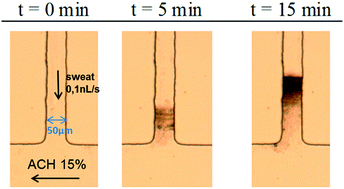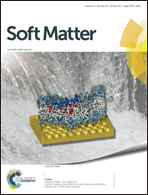The mechanism of eccrine sweat pore plugging by aluminium salts using microfluidics combined with small angle X-ray scattering†
Abstract
Aluminium salts are widely used to control sweating for personal hygiene purposes. Their mechanism of action as antiperspirants was previously thought to be a superficial plugging of eccrine sweat pores by the aluminium hydroxide gel. Here we present a microfluidic T junction device that mimics sweat ducts, and is designed for the real time study of interactions between sweat and ACH (Aluminium Chloro Hydrate) under conditions that lead to plug formation. We used this device to image and measure the diffusion of aluminium polycationic species in sweat counter flow. We report the results of small angle X-ray scattering experiments performed to determine the structure and composition of the plug, using BSA (Bovine Serum Albumin) as a model of sweat proteins. Our results show that pore occlusion occurs as a result of the aggregation of sweat proteins by aluminium polycations. Mapping of the device shows that this aggregation is initiated in the T junction at the location where the flow of aluminium polycations joins the flow of BSA. The mechanism involves two stages: (1) a nucleation stage in which aggregates of protein and polycations bind to the wall of the sweat duct and form a tenuous membrane, which extends across the junction; (2) a growth stage in which this membrane collects proteins that are carried by hydrodynamic flow in the sweat channel and polycations that diffuse into this channel. These results could open up perspectives to find new antiperspirant agents with an improved efficacy.



 Please wait while we load your content...
Please wait while we load your content...